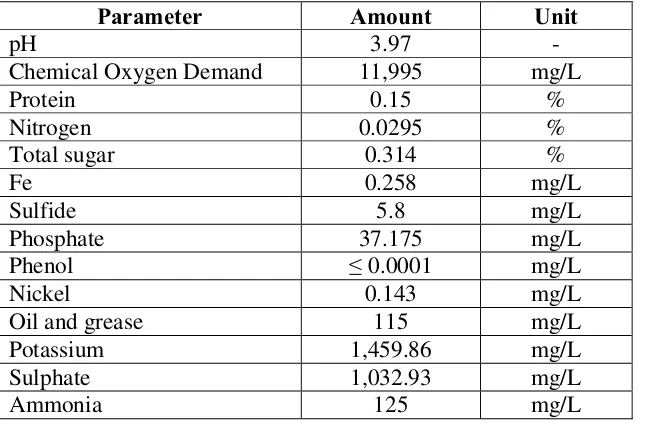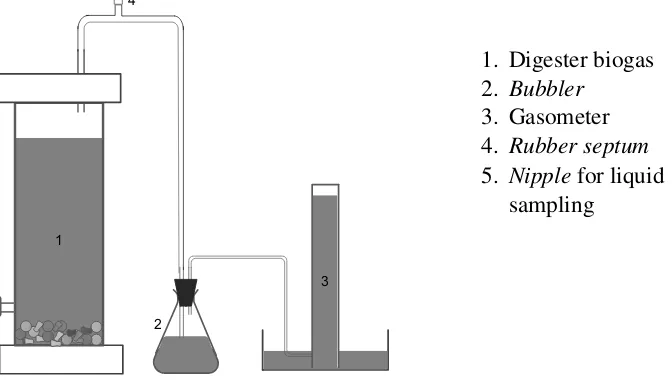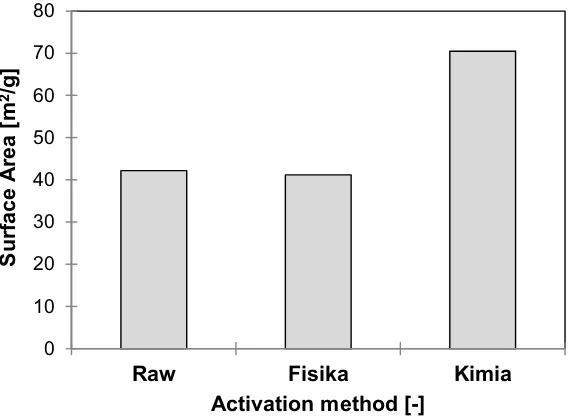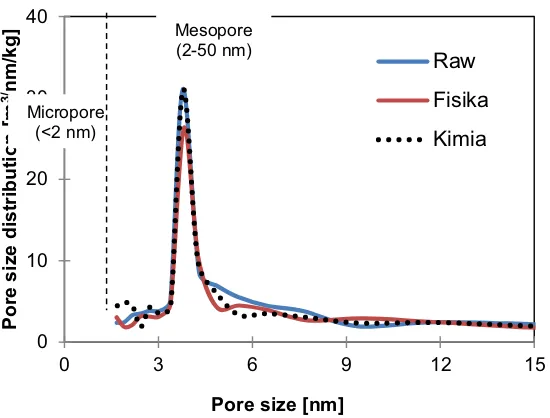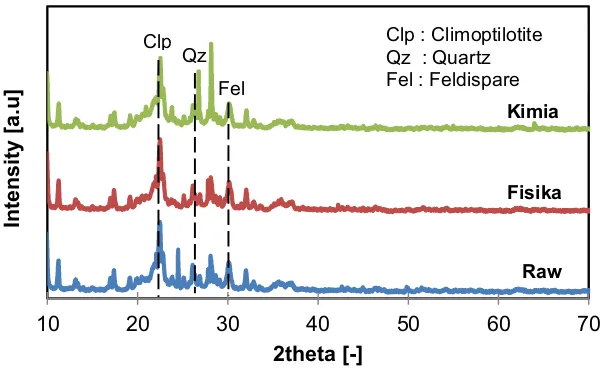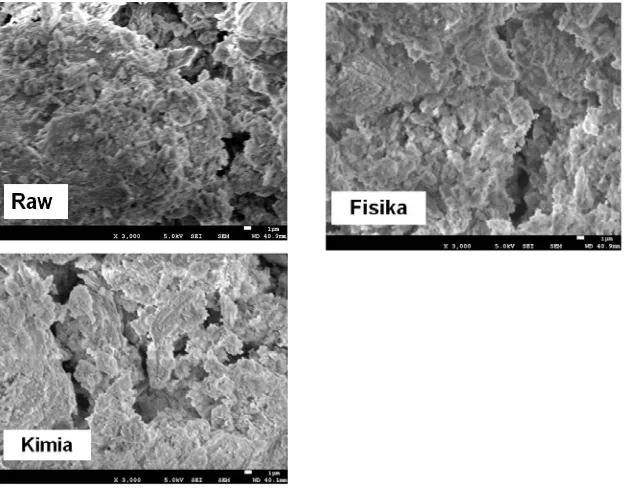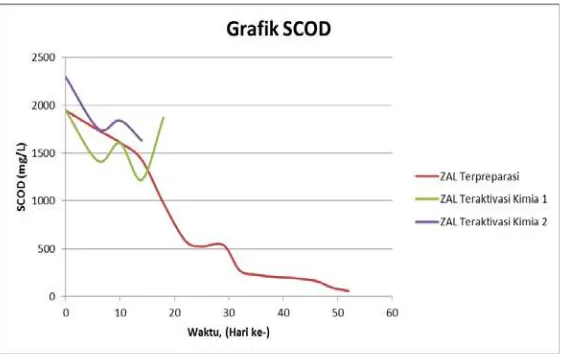PAPER • OPEN ACCESS
Characterization of modified zeolite as microbial
immobilization media on POME anaerobic
digestion
To cite this article: Rochim B Cahyono et al 2018 IOP Conf. Ser.: Mater. Sci. Eng.316 012070
View the article online for updates and enhancements.
Related content
Kinetics of Anaerobic Digestion of Palm Oil Mill Effluent (POME) in Double-Stage Batch Bioreactor with Recirculation and Fluidization of Microbial Immobilization Media
L I Ramadhani, S I Damayanti, H Sudibyo et al.
-Modeling Lab-sized Anaerobic Fluidized Bed Reactor (AFBR) for Palm Oil Mill Effluent (POME) treatment: from Batch to Continuous Reactors
Muhammad Mufti Azis, Hanifrahmawan Sudibyo and Wiratni Budhijanto
-Influence of Nutrient Impregnated into Zeolite Addition on Anaerobic Digestion of Palm Oil Mill Effluent (POME)
M Mellyanawaty, F M A Chusna, H Sudibyo et al.
-1
Content from this work may be used under the terms of theCreative Commons Attribution 3.0 licence. Any further distribution of this work must maintain attribution to the author(s) and the title of the work, journal citation and DOI.
Published under licence by IOP Publishing Ltd
CHARACTERIZATION OF MODIFIED ZEOLITE AS MICROBIAL IMMOBILIZATION MEDIA ON POME ANAEROBIC DIGESTION
Rochim B Cahyonoa,*, Sri Ismiyatib, Simparmin Br Gintingb, Melly Mellyanawatyc, Wiratni Budhijantoa
a
Department of Chemical Engineering, Faculty of Engineering, Universitas Gadjah Mada, Yogyakarta, Indonesia
b
Department of Chemical Engineering, Faculty of Engineering, Lampung University, Bandar Lampung, Indonesia.
c
Department of Environmental Engineering, Faculty of Engineering, Universitas Muhammadiyah Tasikmalaya, Tasikmalaya, Indonesia
*Corresponding Author’s: [email protected]
ABSTRACT
As the world’s biggest palm oil producer, Indonesia generates also huge amount of Palm Oil Mill Effluent (POME) wastewater and causes serious problem in environment. In conventional method, POME was converted into biogas using lagoon system which required extensive land area. Anaerobic Fluidized Bed Reactor (AFBR) proposes more effective biogas producing with smaller land area. In the proposed system, a immobilization media would be main factor for enhancing productivity. This research studied on characterization of Lampung natural zeolite as immobilization media in the AFBR system for POME treatment. Various activation method such as physical and chemical were attempted to create more suitable material which has larger surface area, pore size distribution as well as excellent surface structures. The physical method was applied by heating up the material till 400oC while HCl was used on the chemical activation. Based on the result, the chemical activation increased the surface area significantly into 71 m2/g compared to physical as well as original zeolite. The strong acid material was quite effective to enforce the impurities within zeolite pore structure compared to heating up the material. According to distribution data, the Lampung zeolite owned the pore size with the range of 3 – 5 μm which was mesopore material. The pore size was appropriate for immobilization media as it was smaller than size of biogas microbial. The XRD patterns verified that chemical activation could maintain the zeolite structure as the original. Obviously, the SEM photograph showed apparent structure and pore size on the modified zeolite using chemical method. The testing of modified zeolite on the batch system was done to evaluate the characterization process. The modified zeolite using chemical process resulted fast reduction of COD and stabilized the volatile fatty acid as the intermediate product of anaerobic digestion, especially in the beginning of the process. Therefore, the chemical activation process was most suitable to produce the immobilization media from Lampung natural zeolite for POME waste treatment
1. INTRODUCTION
The world palm oil industry is growing up continuously to fulfill the human needs related to food and hygiene products. Indonesia produced 32.5 million tons of palm oil this year. It renders Indonesia as largest palm oil producer in the world that supply around 45% of total global demand. During palm oil production, this industry generates huge liquid waste, called Palm Oil Mill Effluent (POME) which has high polluting properties such as 25000 mg/l Biological Oxygen Demand (BOD), 55000 mg/l Chemical Oxygen Demand (COD) and 19610 mg/l of Suspended Solid (SS) [1]. Thus, direct releasing of POME into the surroundings would cause pollution and environment degradation. Conventional anaerobic digestion using pond system has been utilized as common and primary method for processing of POME in Indonesia which needs large land and small gas production. In addition, the method has also limitation to handle POME as substrates with high content of inhibitor. In order to resolve the problem, the development of anaerobic digestion using immobilize cell is proposed which own some advantages such as contain more amount of bacteria, prolong the residence time as well as reduction of reactor volume [2]. Cell immobilization is a treatment using limited motion of the bacteria within the reactor using specific space or porous material. By this method, the combination of high cell concentration and flow rate would improve the productivity. The porous material would enhance the contact between substrate and bacteria to increase the biogas production.
Commonly, the material contains several cation such as K
3
2. METHODOLOGY/ EXPERIMENTAL 2.1. Material
Natural zeolite ((klinoptilolit) was obtained from CV. Minatama Lampung. In order to avoid effect of particle size on the experiment, the zeolite was crushed and sieved to similar size. That zeolite was washed using aquadest and dried in an oven at 110oC for 3 h. The main properties of the zeolite were listed in the Table 1. Raw material of POME was obtained from ponds in a palm oil mill located in Lampung, Indonesia which the characteristic as shown in the Table 2.
Table 1. The main properties of natural zeolite from Lampung Chemical
Table 2. Characterization of POME as substrate in the anaerobic process.
Parameter Amount Unit
pH 3.97 -
Chemical Oxygen Demand 11,995 mg/L
Protein 0.15 %
Potassium 1,459.86 mg/L
Sulphate 1,032.93 mg/L
2.2. Experiment procedure a. Zeolite activation process
In the physical activation, the natural zeolite was washed and heated inside the furnace with air atmosphere and temperature of 400oC for 3 hours. While the chemical activation was done by using HCl 2M to wash and soak the natural zeolite in the room temperature for 3 hours. Subsequently, the zeolite was sieved and washed using aquadest until the pH 7 and then dried inside the oven on temperature of 110oC for 3 hours. The cooling process was proceed using desiccators for both physical and chemical activation. Several characterizations were applied to evaluate the activation process such as surface area, pore volume, XRD.
a. Anaerobic digester using POME as substrate
The activated zeolite was tested on the anaerobic digestion using POME as substrate based on equipment which was shown in the Figure 1. The anaerobic digester was equipped with digester, bubbler and gasometer. The digester was constructed from acrylic with the diameter of 9.4 cm and total volume of 2.8 liter. The gas production was indicated by bubbler which was made by Erlenmeyer 250 mL and measured by gasometer. The gasometer was filled with acidified salt water to reduce biogas solubility [13].
Figure 1. The experiment apparatus for batch anaerobic process
The experiment was carried out in duplicate for 40 days in room temperature. Diluted POME (SCOD 2,000 mg/L) and digested cow manure were mixed with ratio 3:1 (v/v) and filled into the digester without pH adjustment. Different masses of zeolite were added, i.e. 280, 560, and 840 g zeolite/ g SCOD digester liquid, and one digester was set as control without zeolite addition. The nitrogen flushing was done for five minutes before the observation.
1. Digester biogas 2. Bubbler
3. Gasometer 4. Rubber septum 5. Nipple for liquid
5
Biogas production was calculated using the through gasometer equation. The determination of soluble chemical oxygen demand was carried out by closed reflux colorimetric method (APHA, 2005) by means of COD heater HI 839800 and Hach DR 900 colorimeter. The analysis of volatile fatty acid was conducted by distillation method, resulting VFA concentration as acetic acid. The pH was measured by Lutron pH meter PH-208, calibrated with 7.0 buffer solution. Methane concentration was measured by Gas Chromatography Shimadzu GC 8A, Japan. The number of total anaerobic bacteria was analyzed by total plate count procedure
3. RESULTS AND DISCUSSION
3.1. Zeolite activation and characterization
Figure 2. Effect of activation method on the zeolite surface area
As mentioned before that surface area of immobilization medium was key parameter on this anaerobic process. Figure 2 shows the effect of activation method on zeolite surface area. Cleary that physical activation resulted no significant effect on the surface area while the chemical activation generated more surface area, around twice within the zeolite material. The physical activation using heating up process was ineffective to remove the impurities which attach strongly within zeolite surface. It was different with chemical activation which used HCl to dissolve the impurities. Those activated zeolite owned high surface area, around 71 m2/g. Therefore, the chemical activation was more effective to remove the impurities and enhance the surface area compared to physical activation. However, the activation process should maintain the original structure of zeolite which was effective in the immobilization process.
Figure 3. Pore side distribution of zeolite in each activation process
Beside the surface area, the pore size distribution as a effect of activation method was evaluated and shown in the Figure 3. Generally, the activation method was not change the pore size distribution significantly since the profile of distribution line was quite dense. The activated zeolite holds pore size of 4 nm, predominantly. In detail evaluation, it was shown that the chemical activation create more pore in the size of 4 nm compared to physical activation. This result confirmed the surface area analysis that the chemical activation was more effective to produce activated zeolite as immobilization agent in viewpoint of available space for microorganism. In addition, the pore size of Lampung zeolite was categorized as mesopore region which was more than 2 nm. This condition offer more advantages when it used as immobilization agent because the biogas microorganism could not penetrate into pore area. The microorganism would lodge in the surface of zeolite material and have more contact with substrate to improve the degradation process. Therefore, the surface morphology of zeolite was key parameter in this anaerobic process.
.
0 10 20 30 40
0 3 6 9 12 15
Pore size distribution [m
3/nm/kg]
Pore size [nm]
Raw
Fisika
Kimia
Mesopore (2-50 nm)
7
Figure 4. X-Ray Diffaraction (XRD) pattern of Lampung zeolite in each activation process.
Figure 4 shows the crystalline structure of Lampung zeolite in each experimental treatment. The natural zeolite had some crystalline such as climoptilotite, quartz, and feldispare. Obviously, this structure was maintained stable in each activation process. It confirmed that the chemical activation could generate more surface area, pore size with stable crystalline structure. This activation process removed only impurities without break the structure of zeolite material. It was important result to have the immobilization agent with high space for microorganism and good surface structure.
10 20 30 40 50 60 70
Intensity
[a.u]
2theta [-] Clpp
Qz
Fel
Clp : Climoptilotite Qz : Quartz Fel : Feldispare
Figure 5. SEM Photo of Lampung zeolite in various activation process.
Figure 5 shows SEM photo of the zeolite in each experiment treatment with similar enlargement. This photo could be used to analyze the effect activation process on the surface of the zeolite. Clearly, the activation step resulted the clean and bright zeolite material. Chemical activation created brighter material compared to physical activation which indicated the cleanness of the material. Again, the SEM photo confirmed that the chemical activation produced better material for immobilization agent in the anaerobic process.
9
3.2.Testing on Immobilization-anaerobic process
Figure 6. Effect zeolite as immobilization agent on the anaerobic process
Figure 6 shows the average sCOD concentration during the batch anaerobic process using POME as substrate and activated zeolite as immobilization agent. Generally, the anaerobic process using zeolite demonstrated normal process which was indicated by decreasing of sCOD during the experiment. In beginning reaction, the chemical activated zeolite shows better performance compared to natural zeolite which was indicated by high decreasing rate of sCOD. Even the testing was limited by time, this result offer great possibility to use natural zeolite as immobilization agent in the anaerobic process using POME as substrates.
4. CONCLUSION
Chemical activation on Lampung zeolite offered promising result for anaerobic-immobilization process in term of high surface area as well as pore size distribution. In addition, the crystalline structure was stable and maintain in place during the activation process. Anaerobic testing using activated zeolite showed that the material had high possibility as immobilization agent.
5. REFERENCES
[1] Khanal.S. Kumar., (2008), Biotechnology for Bioenergy Production : Principles and Application, University of Hawai’i Manoa, Wiley-Blackwell, John Wiley and Sons Publication
[2] Shuler, M. and Kargi, F., 2002, Bioprocess Engineering Basic Concepts 2 nd
Ed.,
Prentice Hall, New Jersey
[4] Montalvo, S., Guerrero, L., Borja, R., Sánchez, E., Milán, Z., Cortés, I., Rubia, MA., (2012), Application of natural zeolits in anaerobic digestion processes: A review, Applied Clay Science 58: 125–133
[5] Borja, R., Sanchez, E., Weiland, P., Travieso, L., dan Martin, A., (1994), Kinetics of Anaerobic Digestion of Cow Manure with Biomass Immobilized on Zeolite,
Chemical Engineering Journal, 54, B9-B14.
[6] Fernández, N., Montalvo, S., Polanco, F., Guerrero, L., Cortés, I., Borja, R.,
Sánchéz, E, dan Travieso, L., (2007), Real Evidence About Zeolite as
Microorganisms Immobilizer in Anaerobic Fluidized Bed Reactor, Journal of Process Biochemistry, 42: 721-728
[7] Rosita, N., Erawati, T., Moegihardjo, M., (2004), Effect of activation method on zeolite effectiveness as adsorbent (in Bahasa Indonesia). Majalah Farmasi Airlangga, 4 No. 1, 20-25.
[8] Jozefaciuk, G., Bowanko, G., (2002), Effect of Acid and Alkali Treatments on Surface Areas and Adsorption Energies of Selected Minerals, Journal Clays and Clay Minerals, 50 No. 6, 771- 783
